Aesthetics and Kinetics: The Pivot Door is Here to Stay with John DeRosa of Bridgeport Worldwide
Pivot doors have been around for millennia, first recorded in ancient Egypt, Greece and Rome. You’ve probably seen them in movies like Indiana Jones or TV shows like Atlanta as secret panel doors. They’re not a new technology, but in the United States, seeing them as the front door of a home feels pretty new.
The trend is making it’s way from across the seas, and with upgrades in installation technologies, manufacturers and designers are looking to pivot doors as the next upgrade for the traditional hinged door. John DeRosa, part of the Building Development team at Bridgeport Worldwide, came on today’s AEC Podcast to give insight on why pivot doors are finally taking mainstream hold in the States, how Bridgeport is aiming to be the point-of-contact for pivot door solutions, and how both their aesthetics and practicality shouldn’t be ignored.
Daniel Litwin: I’m excited to dive into this really interesting topic in the AEC world which is pivot doors. I feel like the whole door world hasn’t seen a lot of change in, I mean, decades. When you think of a door, you think, “All right, door, opens at the hinges, opens on the side.” But pivot doors are really changing all of that and it’s a cool trend that’s made its way from Europe to the United States and is having a lasting impact. And I know Bridgeport Worldwide is trying to be one of the people at the forefront of that change. 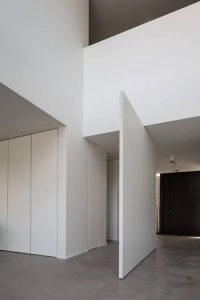
So I want to know from you first before we get into some of the specifics is just learning a little bit more about pivot doors in general. Could you tell me a bit about the origin of pivot doors? How they came up in Europe and then how they made their way to the United States and what kind of impact they’re having here?
John DeRosa: You know, it’s funny. I think pivot doors have always been around, but we never really noticed them, and you’re right, and that they are different from traditional doors. You know traditional doors we know to have hinges on the side, side-hinged doors. Pivot doors, the hardware, is a little bit different. It’s mounted on the top and the bottom of the door and really pivot hardware traditionally has been used for perhaps doors that have more frequency or doors that are used in the commercial spaces. And traditionally, pivot hardware has been used on commercial doors. But what we’re seeing now is with pivot hardware being advanced technologically that the pivot door is entering other worlds or other spaces of the building industry, specifically residential and more in commercial.
So historically, I think they’ve kind of been all around. We don’t really notice them that much. A lot of store-front doors are pivot doors. There’s different types of pivot hardware, offset hardware, or centered mounted hardware. If you look on a lot of doors that we probably open every day going into the supermarket, very well could be a pivot door. But throughout the world, places like Europe and Australia and other parts of the world, the pivot door has been used for some time as in different respects. It’s been used as the front door for your home, and especially in Europe, door hardware in particular, parts of Europe, are way far ahead of where we are today. We’re still using 60-year-old technology with respect to pivot hardware here in the US and Canada.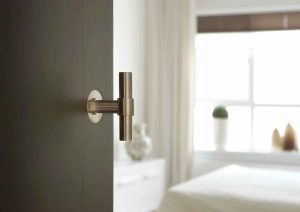
DL: Well, I remember I was in Spain last summer for a study-abroad trip and I mean it was a fabulous experience and I noticed a lot of architectural differences, but pivot doors were something that I noticed right off the bat because they were in my co-working space, they were in a lot of residential areas when I went over to people’s apartments or even at my residential complex. Some of the main entrances to and from large spaces were a pivot door and that was something really foreign to me because I don’t really see a lot of that here in the States. And if it’s here, it’s probably more unique. It stands out like, “Whoa! What a strange door concept.” But it was so integrated there in Europe. Why don’t you think that has become a thing in the United States or it hasn’t caught on as quickly or as sturdily?
JD: You know, perhaps it just takes a little bit of time. I mean today, where we see, let’s say the pivot entry door on a home is in the super premium spaces. So in very premium homes, you’re going to see a big huge pivot door as the entrance to that home. So what we found, and again to do that work, you got to use the traditional hardware, you got to dig in the floor and put a closer bucket in the floor or in the ceiling to hang that pivot door and make it work, make it operate with a closer.
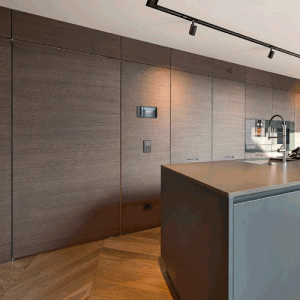 The advent of this new type of pivot hardware, which is concealed in the door, it allows for the pivot door to be easily used in any situation. I mean the big reason I think why you don’t see them that often here is because contractors don’t like them. People don’t like installing pivot doors. They’re challenging. It involves a whole extra week of work to dig into a floor and put a closer in there and patch the floor and match it to the existing flooring or cover it with a threshold and it involves more trades. It’s just a lot of work.
The advent of this new type of pivot hardware, which is concealed in the door, it allows for the pivot door to be easily used in any situation. I mean the big reason I think why you don’t see them that often here is because contractors don’t like them. People don’t like installing pivot doors. They’re challenging. It involves a whole extra week of work to dig into a floor and put a closer in there and patch the floor and match it to the existing flooring or cover it with a threshold and it involves more trades. It’s just a lot of work.
What we’re experiencing now with this new pivot hardware that’s concealed within the door, it just makes it so much easier. So I think we’re at the very beginning of seeing an increase in the use of the pivot door here and where are we seeing it.
DR: I think it’s also reflective of an aesthetic thing going through from Europe to the United States, this really kind of flush architecture doors and other installations that all appear really seamless. You don’t see a lot of differences between the window to the door or to the wall. Everything feels really flushed and integrated. Do you feel like that is also a reason why pivot doors are starting to see more of a surge to the United States, is also that aesthetic side of things?
JD: Absolutely. The Europeans, they’re not afraid to take risks. You’re right, it’s about the look, the look of the pivot doors. It’s definitely a cool thing, but it’s also performance driven as well because as these doors get bigger, they can’t be held with traditional hinges on the side of the door. Making a door or a pivot door instead of a hinged door on the side is a performance thing as well and the Europeans are very performance-driven. So that’s most likely a part of it as well is they’re seeking performance, the pivot door is in theory a performance-driven door. But it’s also unique from a design standpoint. You know I would say the Europeans are not afraid to take risks and so that’s why some of these things happen there first.
DR: You know, I feel like with this flow from Europe to the United States with the pivot door, I think a lot of people trying to install them whether it’s businesses themselves who are looking to make their space a little trendier or it’s people installing them haven’t had a lot of experience with bringing a pivot door into a commercial or residential space. And I think that requires some training. So what have been the biggest issues, biggest challenges with getting a pivot door in residential or commercial spaces here that you’ve noticed?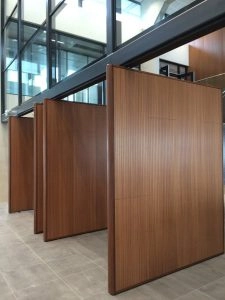
JD: Well, I think the biggest challenge was really finding out what the manufacturers of doors are doing today. Part of my initial focus here at Bridgeport Worldwide was to take our pivot hardware, which is the FritsJurgens pivot hardware from Holland, and do some outreach and talk to these door manufacturers, and we’re talking major door manufacturers, and find out what they’re doing about their pivot doors. Because one of the reasons why we don’t see pivot doors as a standard option of your front door of your home is because the manufacturers have to catch up and start producing them.
So what I found in my outreach to all these major manufacturers is that some of them, only a small handful of them actually already had a pivot door productized and they were selling it. They’re using different hardware and they quickly switched to the FritsJurgens hardware because it just made so much sense to do that. But in working with all the other manufacturers is really interesting. The responses I would get from the product managers or the heads of engineering or marketing folks at these manufacturers is, “Yeah, you know what? We do them. We get the request. We do them the best way we know how. We don’t have it productized. It’s not a part of our suite. You can’t find it on our website, but we get the request and we do them.”
It’s really interesting because it is still very early, but what happens is when I introduce them to the FritsJurgens hardware, it really is sort of mind blowing that they’re very intrigued by the hardware. They look at it and say, “Wow! This takes a lot of the challenges out of hanging a pivot door. We could make a door around this.” And so they did. And we have many manufacturers right now.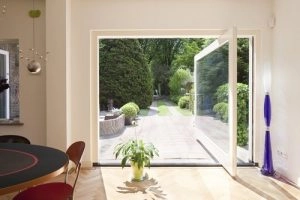
Well, you know, it’s been the past year, it’s over the past year. With all this outreach, we’ve had many manufacturers said, “Wow! This is great. This gives us the opportunity to make a pivot door. We’re going to go ahead and do it.” But that still takes six months to a year for them to get that product up and running and out the door. So it’s neat because it’s happening, it also takes a lot of time, but the manufacturers are doing it. They all know. They got to do it and many of them are taking the steps to do it.
To read more about Bridgeport Worldwide.
For the latest news, videos, and podcasts in the AEC Industry, be sure to subscribe to our industry publication.
Follow us on social media for the latest updates in B2B!
Twitter – @AECMKSL
Facebook – facebook.com/marketscale
LinkedIn – linkedin.com/company/marketscale








